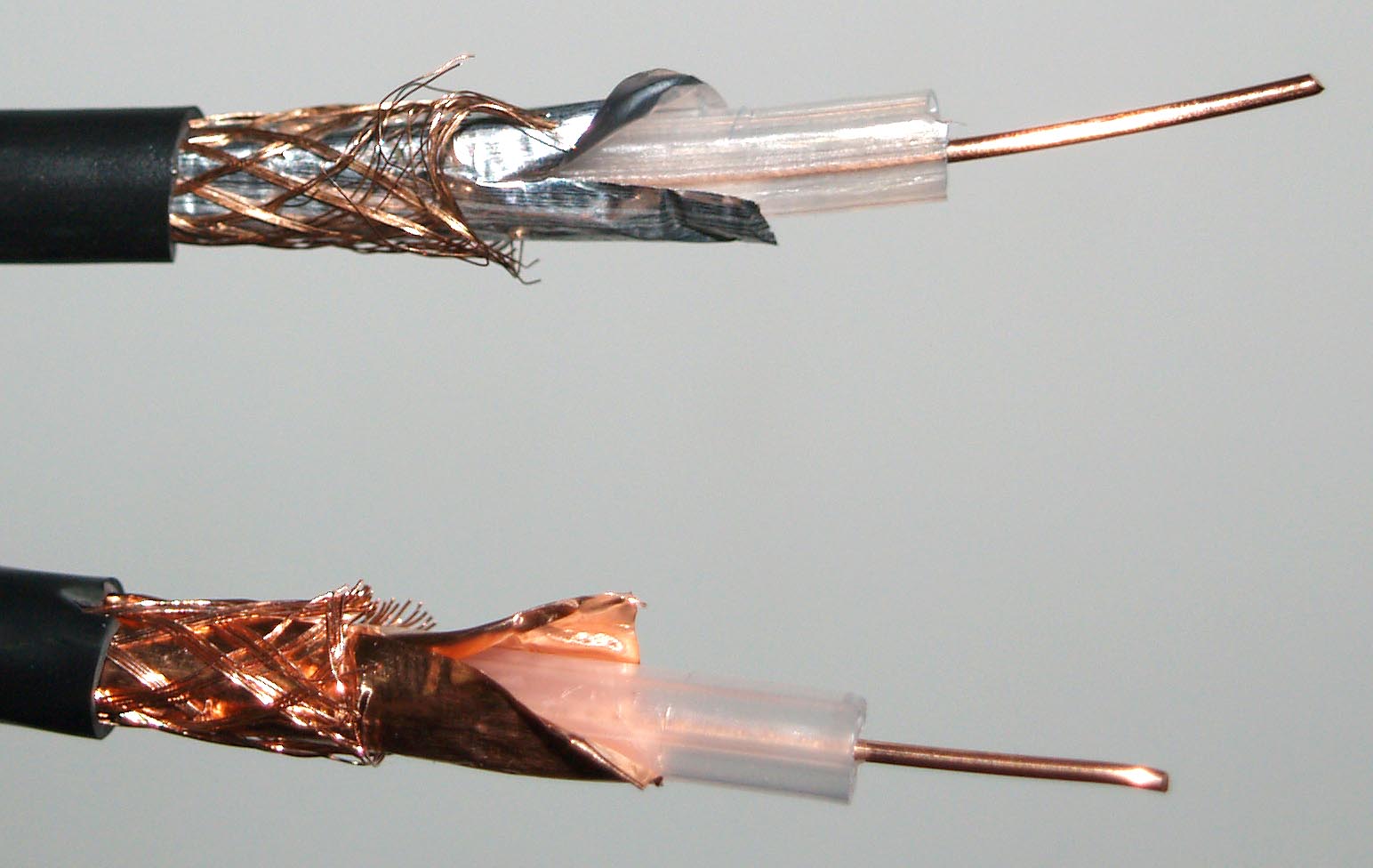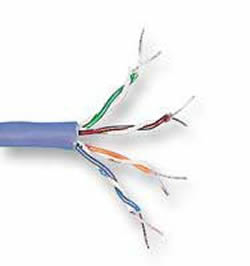| Back |
There are three types of cable used for audiovisual, television and data network signals, co-axial cable, twisted-pair cable and figure of eight twin. It is important to use the correct cable as otherwise there will be serious loss of signal (attenuation) and interference (noise) will be picked up.
Some people insist on using the correct names. A cable comes in uncut lengths to be cut to length, perhaps to have connectors fitted on each end and possibly be permanently installed. The things you buy ready made to connect equipment are called leads or wires.
Coaxial (co-ax) cables have a core conductor which is usually a single copper wire. This is surrounded by a layer of plastic insulation, also called 'dielectric'. This partially determines the impedance of the cable. Around the dielectric are one or more layers of screening. One is usually a woven copper braid, and there might be one or more additional screens of aluminium or copper foil, or of thin metallised mylar plastic. All of this is covered by a tough outer protective sheath.
Co-ax cables are used for connecting up terrestrial aerials and satellite dishes and for audio signals.

For terrestrial television signals you should use a high-quality co-ax cable similar to the upper picture above. A thick cable loses about 25 dB per 100 m, but the signal are relatively high and you can use amplifiers to boost it before sending it down very long runs.
Satellite signals have a much higher frequency so losses are higher. The signal is much smaller than terrestrial as well. However if you amplify it you add noise and in the end it is the carrier to noise ratio (CNR) that is critical. The key then is to use only top quality cable and use thicker cable for longer runs. The three types normally used are CT100/WF100 (the F means it has foam dielectric), CT125 and CT165. The table shows the diameter and the losses in dB per 100m of each type. The CT100, 125 and 165 cables must not be bent sharply as the hollow dielectric will be crushed. Where sharpish bends are unavoidable the WF100 foam-filled cable should be used. The numbers under the 860 and 2150 MHz headings are the signal losses in dB per 100m.
Dia mm |
860 MHz |
2150 MHz |
Use | |
CT100/WF100 |
6.8 |
18 |
30 |
Normal wiring |
CT125 |
8.1 |
15 |
25 |
Trunks/ long runs |
CT165 |
10.1 |
13 |
21 |
Trunks/very long runs |
This picture shows a cheap but good quality cable above and Webro CT100 below. Notice the higher density braiding on the CT100. The inner shield is thick copper on the CT100 and thin, fragile aluminium on the other. What you can't see is that the core on the cheap cable easily slides in the aluminium shield so could be displaced, and make a poor connection, when pushing a short length of cable into a connector.

RG59 and RG6 are often used for audiovisual connections.
RG59 |
RG6 |
|
Overall diameter (mm) |
4.95 |
6.9 |
Attenuation
dB/100m |
||
MHz |
||
50 |
8 |
5.3 |
100 |
12 |
8.5 |
200 |
18 |
10 |
400 |
24 |
12.5 |
900 |
39.5 |
21 |
RG59 might have a solid copper or copper-plated steel core. Steel is less flexible.
These are the twin screened core cable for S-video, three screened plus four unscreened for SVGA, three screened for RGB and so on. These can be bought by the metre. If you are installing permanently to wall plates it is usually cheaper to buy high quality made up cables of the correct length and then cut off the end connectors.
As its name suggests this is a cable with two wires for each signal, one for the outgoing and the other for the returning signal. This type of connection is also called 'balanced'. The wires are twisted around each other so any interference created is equal in each and so cancels. The number of twists per metre is specified, as is the length of untwisted ends as they attach to the connectors. The pair might be screened or unscreened. Twisting increases the length of the cores within the cables, so it is important that in multi-pair cable the twists per metre is the same for each pair, or data in one pair might be out of synchronism with another. Category 5 network cable is sometimes used for audio-visual connections and HDMI cables have four screened, twisted pairs. The picture shows category 5 (cat5) network cable. This is increasingly used for audiovisual connections.

This is a cable with two insulated conductors joined together to form the shape of an eight. It is mostly used for loudspeakers. Always use the thickest cable you can, as speakers use high currents, and thin cable will waste the amplifier's power. This is especially true of sub-woofers, which need a very high current. Cables are described either by the cross-sectional area in square mm or by the number and diameter of the wire strands that they contain. As an example the fairly heavy cable shown below has a conductor area of 1.5mm² and 189/0.1mm which means 189 strands each 0.1 mm diameter.

This is a wire that literally goes into the earth. It is always near to zero volts and will carry away any electrical charge that builds up on metal objects. Earth is the UK word and ground is the US one. On equipment, connecting the mains yellow/green core means that the metal case is now earthed for safety. A lot of equipment only has a twin mains wire, but has additional insulation instead of an earth.
Screening braid and foil is connected to earth to reduce interference. It is also often called 'return' as the braid is used to complete the signal circuit. In these pages the word ground is mostly used as this is most common. The exceptions are when talking about earth loops and earth bonding, as these are the usual terms in the UK.
Earth (ground) loops allow the mains to induce 50Hz signals in the signal cables. This can cause audio hum or video patterns. Various techniques are used to avoid them. On mounted connectors, plastic washers insulate them from the metal case or plate and hence from each other. When connecting two pieces of equipment, audio hum can often be cured by connecting the screen braid at both ends of only one of the wires. The screens in the other wires are connected at one end only.
| Back |
(C) Peter Scott 2009
Last edit 26 December 2015